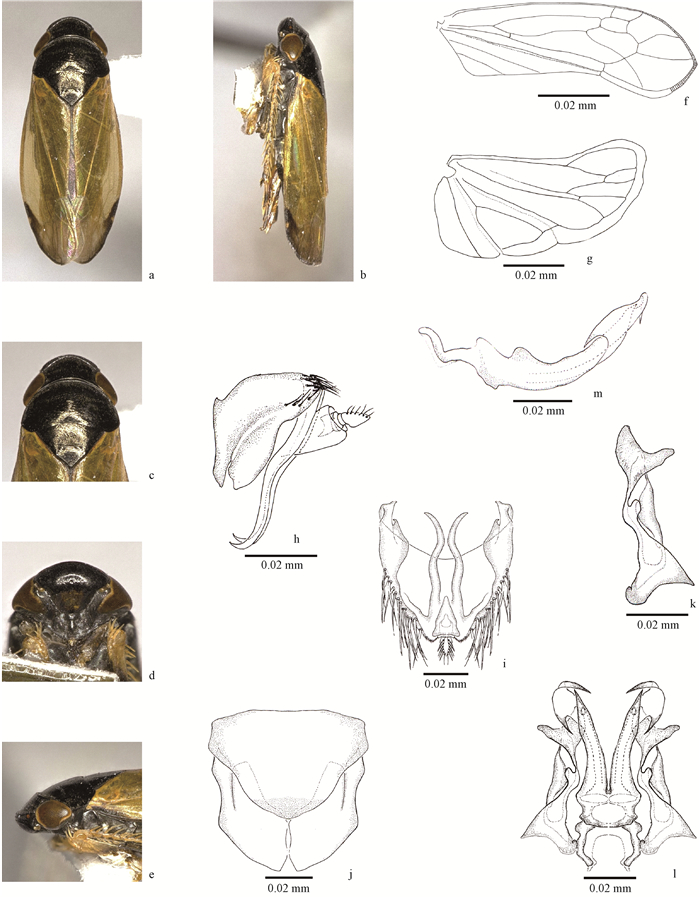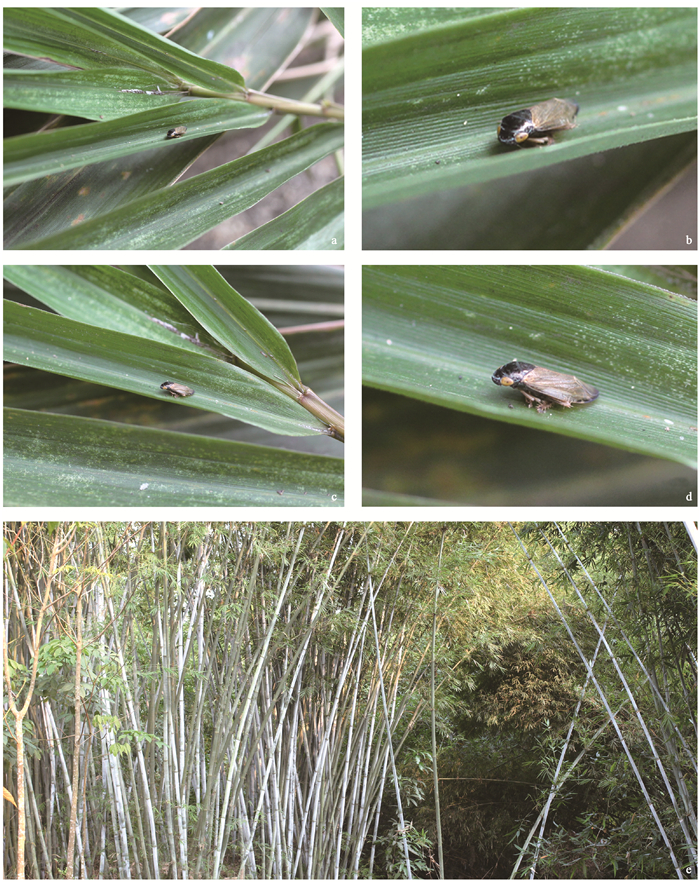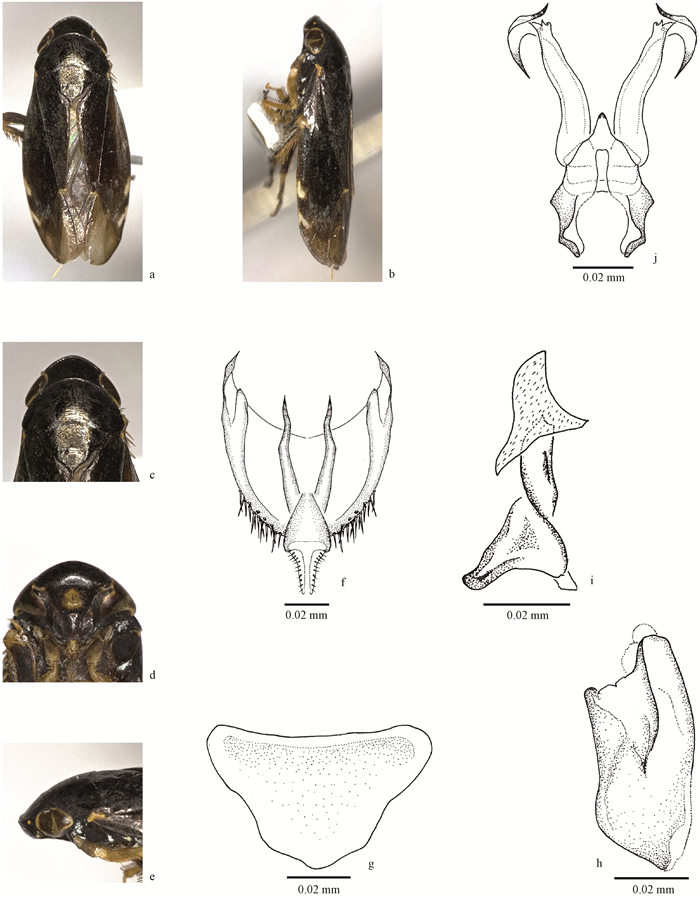文章信息
- Yao Yalin, Chen Xiangsheng, Yang Lin
- 姚亚林, 陈祥盛, 杨琳
- A New Bambusa chungii Feeding Species of the Genus Mukaria Distant (Hemiptera: Cicadellidae: Deltocephalinae: Mukariini) from China
- 取食危害粉单竹的额垠叶蝉属一新种(半翅目:叶蝉科:角顶叶蝉亚科:额垠叶蝉族)
- Scientia Silvae Sinicae, 2019, 55(7): 105-110.
- 林业科学, 2019, 55(7): 105-110.
- DOI: 10.11707/j.1001-7488.20190711
-
文章历史
Received date: 2017-10-22
Revised date: 2019-03-21
-
作者相关文章
2. 贵州大学昆虫资源开发利用省级特色重点实验室 贵阳 550025;
3. 贵州大学昆虫研究所 贵阳 550025;
4. 贵州大学贵州山地农业病虫害省级重点实验室 贵阳 550025
2. Special Key Laboratory for Development and Utilization of Insect Resources of Guizhou University Guiyang 550025;
3. Institute of Entomology, Guizhou University Guiyang 550025;
4. Key laboratory for Plant Pests Management of Mountainous Region in Guizhou Province Guiyang 550025
The genus Mukaria was erected by Distant in 1908, based on the type species Mukaria penthimioides Distant from Sri Lanka, belonging to the subfamily Deltocephalinae (Cicadellidae) and includes 16 species worldwide at present (Viraktamath et al., 2019), with an extremely high diversity of endemic species in the China (nine species) (Yang et al., 2016). The distribution of 14 known species within the genus Mukaria was related to that of their host plant, mainly covering Myanmar, Thailand, Indonesia, and southwest China, where they are known as centre of origin of bamboo (Guo et al., 2002). As a result of recent fieldwork by Yang et al. (2011), members of Mukaria were found feeding exclusively on several native bamboos. In Ryukyu Islands, Japan, M. maculate (Matsumura, 1912) were found feeding on Bambusa multiples Raeuschel and B. vulgaris Schrad (Hayashi, 1996).
In this paper, a new species, Mukaria hainanensis, sp. nov. is described and it was collected on bamboo(Bambusa chungii)leaves of Jianfengling National Natural Reserve, Hainan Province, China, is described and illustrated. A key to Chinese species of the genus Mukaria, and the colour photographs of the new species and its host plants are provided.
1 Material and methodsTerminology follows Li et al. (2011) except leg chaetotaxy, which follows Rakitov (1997). Dry specimens were used for the descriptions and illustrations. External morphology was observed under a stereoscopic microscope and characters were measured with an ocular micrometer. Measurements are given in millimeters; body length is measured from the apex of the head to apex of the forewing in repose. The genital segments of the examined specimens were macerated in 10% KOH, washed in water and transferred to glycerin. Illustrations of the specimens were made with a Leica MZ 12.5 stereomicroscope. Photographs were obtained with a Leica D-lux 3 digital camera. The digital images were then imported into Adobe Photoshop 8.0 for labeling and plate composition.
Type specimens of the new species are deposited in the Institute of Entomology, Guizhou University, Guiyang, China (IEGU).
2 TaxonomyKey to Chinese species of Mukaria Distant, 1908 (Modified from Yang & Chen, 2011)
1. Ventral margin of pygofer with one or tow processes……………………………………………2
- Ventral margin of pygofer without process……………………………………………7
2. Ventral margin of pygofer with two processes……………………………………………M. maculata (Matsumura)
- Ventral margin of pygofer with one process……………………………………………3
3. Process of ventral margin of pygofer, short, tooth-like ………… M. yanheensis Chen, Yang & Li
- Process of ventral margin of pygofer long, without tooth-like……………………………………………4
4. Subgenital plate broad at base, apical 1/3 abruptly narrowing, membranous……………………………………………M. bambusana Li & Chen
- Subgenital plate quadrate, apex slightly acute, not membranous……………………………………………5
5. Ventral margin of pygofer with finger-like process; aedeagal shaft with two apical and two lateral processes, subequal to each other……………………………………………M. flavida Cai & Ge
- Ventral margin of pygofer with long lanciform process……………………………………………6
6. Forewing blackish brown; base of aedeagus with a big process between two shafts……………………………………………M. albinatata Cai & Ge
- Forewing yellowish brown; base of aedeagus without process between two shafts……………………………………………M. hainanensis sp. nov.
7. Pygofer with finger-like process at dorsal margin near apex……………………………………………M. lii Yang & Chen
Pygofer without process at dorsal margin……………………………………………8
8. Subgenital plate broad at base, apical 1/3 abruptly narrowing to membranous apex……………………………………………M. testacea Chen, Liang & Li
- Subgenital plate quadrate, apex slightly acute, not membranous……………………………………………9
9. Aedeagal shaft with apical margin turncate, separately produced laterad into short process……………………………………………M. pallipes Li & Chen
- Aedeagal shaft with four apical branches, outside ones acute, converging apically, inside ones short, finger-like……………………………………………M. nigra Kuoh & Kuoh
Mukaria hainanensis Yao, Yang & Chen, sp. nov. (Fig. 1a-l, Fig. 2a-d)

|
Fig.1 Mukaria hainanensis sp. nov. a.Adult♂, dorsal view; b. Adult♂, lateral view; c. Head and thorax, dorsal view; d. Face; e. Head and thorax, lateral view; f. Forewing; g. Hindwing; h. Pygofer, lateral view; i. Pygofer, ventral view; j. Valve and subgenital plates, ventral view; k. Style, dorsal view; l. Connective and aedeagus, dorsal view; m. Aedeagus, lateral view. |

|
Fig.2 Mukaria hainanensis sp. nov. and its host plants a-d. Local feeding harm satuation of bamboo by this new species; e. Whol situation of bamboo being harmed by feeding. |
Measurements. Body length including forewing 3.84 mm (male, n=1); forewing length 3.03 mm (male, n=1).
Coloration. General coloration (Fig. 1a-e) shining blackish brown to black. Eyes yellow brown. Face (Fig. 1d) black, central circular region with yellowish-brown. Fore and middle legs (Fig. 1b) yellowish brown, hind legs dark brown except yellowish base of femora and tibiae. Abdomen blackish brown to black. Forewing (Fig. 1a, b) yellowish with subhyaline marking at apical area. Female coloration similar to male.
Head and Thorax. Crown of head with length in median line shorter than width between eyes; coronal suture obscure; ocelli with distance in front of inner margin of eyes about three times as long as its diameter. Frontoclypeus in profile with apex relatively acute; ventral margin convex at apex and concave at base. Pronotum (Fig. 1a-d) longer than crown in median line; mesonotum and scutellum with basal width greater than median length. Forewing slightly wider at apex than at base.
Male genitalia. Male pygofer covered with long macrosetae from middle to apex; pygofer (Fig. 1h, i) with many macrosetae posteriorly and some concave at midventral margin caudally. Ventral margin with long and thin "S" hook process bent on base. Valve (Fig. 1i) broad triangular, apex rounded, basal width greater than apex; subgenital plate (Fig. 1j) broad at base, roundness apically. Aedeagus (Fig. 1l-m) in dorsal view, broad at base, shafts divergent, with two apical branches long, base of aedeagal without a process between shaft. Style broad at base, in apical margin extension with hair-like hydrophobic micro raw (Fig. 1k).
Female. Body length 4.56 - 4.72 mm (female, n=5), forewing length 3.82 - 4.00 mm (female, n=5). Similar to male, but female sternite Ⅶ with posterior margin strongly concave, with short, median bilobed projection.
Material examined. Holotype: ♂, China: Jiangfengling National Natural Reserve, Ledong County, Hainan Province. 5 January 2011, Weibin Zheng; paratypes 5♀♀, data same as holotype.
Host plant. Bamboo (Fig. 2a-e).
Distribution. China (Hainan).
Etymology. The name of new species refers to the location of the new species was collected. Remarks. The new species is closely related to M. ablinotata Cai & Ge, 1996 (Fig. 3a-j), but can be distinguished by the characters below: forewing yellowish brown (blackish brown in ablinotata); ventral process of male pygofer long and sinuate, turning outside apically at ventral view (short and straight in ablinotata); aedeagus without process between two shafts, inside process near apex stout and straight (in ablinotata, aedeagus with a big process between two shafts, inside process near apex small, tooth-like).

|
Fig.3 19-26. Mukaria ablinotata Cai & Ge, 1996 a.Adult♂, dorsal view; b. Adult♂, lateral view; c. Head and thorax, dorsal view; d. Face; e. Head and thorax, lateral view; f. Pygofer, lateral view; g. Subgenital plates, ventral view; h. Valve, ventral view; i. Style, dorsal view; j. Connective and aedeagus, dorsal view. |
Cai P, Ge Z L. 1996. Three new species of Nirvaninae from China (Homoptera:Cicadellidae). Acta Entomologica Sinica, 39(2): 186-190. |
Distant W L. 1908. Family Jassidae. The fauna of British Indian including Ceylon and Burma. Rhynchota, 4: 157-419. |
Guo Z H, Li D Z. 2002. Advances in the systematics and biogeography of the bambusoideae (Gramineae) with remarks on some remaining problems. Acta Botanica Yunnanic, 24(4): 431-438. |
Hayashi M. 1996. Occurrence of Mukariinae (Homoptera, Cicadellidae) in Japan, with description of a new species. Japanese Journal of Entomology, 64(1): 122-130. |
Li Z Z, Dai R H, Xing J C. 2011. Deltocephalinae from China (Hemiptera:Cicadellidae). Beijing: Popular Science Press: 40-44.
|
Matsumura S. 1912. Die Acocephalinen und Bythoscopinen Japans. The Journal of the College of Agriculture, Tohoku Imperial University. Sapporo, Japan, 4, 279-325.
|
Rakitov R A. 1997. On differentiation of cicadellid leg chaetotaxy (Homoptera:Auchenorrhyncha:Membracoidea). Russian Entomological Journal, 6: 7-27. |
Viraktamath C A, Webb M D. 2019. Revision of the bamboo leafhopper tribe Mukariini (Hemiptera:Cicadellidae:Deltocephalinae) from the Indian subcontinent with description of new genera and species. Zootaxa, 4547(1): 001-069. DOI:10.11646/zootaxa.4547.1.1 |
Yang L, Chen X S. 2011. Review of bamboo-feeding leafhoppers genus Mukaria Distant (Hemiptera:Cicadellidae:Mukariinae) with description of a new species from China. Zootaxa, 2882: 27-34. DOI:10.11646/zootaxa.2882.1.3 |
Yang L, Chen X S, Li Z Z. 2016. Bambusimukaria, a new bamboo-feeding leafhopper genus from China, with description of a new species (Hemiptera:Cicadellidae:Deltocephalinae:Mukariini). Zootaxa, 563: 21-32. |
 2019, Vol. 55
2019, Vol. 55

